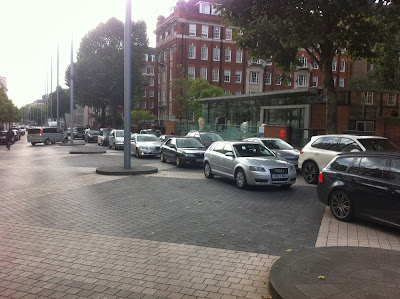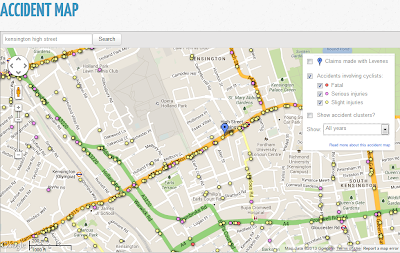Following a
slightly ambiguous report in a local paper about Kensington and Chelsea Council stalling on Cycle Superhighway 9 plans, I assumed that the real reason for my Council's hostility to Cycle Superhighway 9 was not the blue paint but the fact that they hate segregation because it means reduced amounts of space for motor traffic. They take this extremely reactionary position because most of the Councillors are rich residents who own two or more cars and drive everywhere. They don't take the bus, and they certainly don't cycle!
I blogged accordingly but also sought clarification from Cllr Timothy Coleridge, Cabinet member for Transport. I've decided to reproduce his reply to me in full here because it sets out the Council's position in clear, specific terms:
Thank you for your e-mail. You are correct that the Council is not supportive at this time of a segregated cycle route along Kensington high Street.
Kensington high street is extremely busy, but the traffic generally flows well and cars and cycles move through it together and without a great degree of difficulty. The main issues we have is the idea of having a segregated cycle lane on the north side of the street, with cycles going both east and west. Pedestrians wishing to catch the many buses that use the high street would have to cross onto an inner pavement to queue for buses, and more difficult is the very complicated junction with Kensington church street. This junction is extremely difficult to solve. The pinch point as you go east past the Royal Garden Hotel would need to be reduced to one lane of traffic and this would reduce traffic flow to an unacceptable level. Finally the high street has been redesigned to a very high spec and we believe it has greatly improved this busy and important shopping destination.
A few very interesting points to note from this. Firstly, TfL/Gilligan have clearly presented RBKC Council with some very detailed, well thought-out plans for segregation which have been rejected by the Council. The natural corollary of this is that campaigning organisations like London Cycling Campaign need to find a way of putting pressure not just on TfL, but on intransigent local councils too, if they want to see London 'Go Dutch'.
As I blogged about with reference to the Cycle Superhighway 5 consultation in June,
sometimes it is not TfL but other local government bodies who are actively resisting the separation of cycle and motor traffic. TfL are far, far from perfect. But councils like RBKC aren't either.
It's also remarkable that the main stumbling block to a 'segregated cycle lane' is that it will mean at one point the eastbound road will need to be reduced 'one lane of [motor] traffic', which the council see as 'unacceptable'. Given that most of the time Kensington High Street functions as effectively a single lane street because of parked cars/taxis, buses stopping, and rush hour cyclists filling the entire inside lane, it is particularly galling that the council will not consider reducing the street to one motor traffic lane at ANY point. Moreover, Kensington High Street is a shopping street, not a distributor road, so why on earth should it have two lanes of motor traffic in each direction?! It's completely idiotic to preserve needlessly high levels of motor traffic capacity at the expense of safe cycling, mass cycling, reducing illegal levels of air pollution, cutting carbon emissions, reducing the number of those killed and maimed in road traffic accidents, and improving bus and tube overcrowding during rush hour.
If you ask me, this current RBKC Council is living in the 1970s.
As The Ranty Highwayman pointed out on twitter, RBKC Council don't even see pedestrians or cycles as 'traffic' which they have been legally obliged to do since the Traffic Management Act in 2004. Only cars count.
Come the 2014 elections a large part of this evidently useless chaff will hopefully be threshed out of the Council body so more intelligent decisions can be made on behalf of
all Kensington and Chelsea residents (including the 60% of households in the borough that are car-free), not just the predominantly fat and lazy motor-obsessive minority that seem to constitute the majority of the Council at the moment.
Below are some photos I took of Ken High Street (+ Hyde Park Gate and Exhibition Road) yesterday showing just how hostile the current 'very high spec' [Timothy Coleridge's words] design is for cycling, and how frequently it is reduced to one lane of motor traffic:
Absolutely no #space4cycling here.
But many people still forced to use this route due to lack of alternatives.
Fancy a dooring, anyone?
Those on bikes are frequently forced into the very dangerous path of traffic overtaking them from behind due to the lack of a segregated cycle lane. The person in front of me was almost taken out by the blue car (pictured) when I took this.
Another instance of someone being forced into the very dangerous path of traffic overtaking them from behind due to the lack of a segregated cycle lane. Again, there was almost a collision here with the white van (pictured). This road layout is not safe and it's insane to refer to it as 'very high spec' (as Coleridge frequently does).
A bus stop by pass is badly needed here. Would fancy squeezing in the slither of space between the bus and the motor traffic? Or sitting behind the bus and inhaling some lovely carcinogenic diesel until it moved off again?
The road is too dangerous for these people to feel safe cycling, with resultant clogging of the pavement for pedestrians.
This person is cycling across the pedestrian crossing because he's worried about getting killed by the motor traffic.
Pictured again. This is inconvenient for pedestrians. Proper segregated cycling facilities would avoid this.
Exhibition Road. Urgh. What an awful design. Looks terrifying.
It would be difficult to come up with something more hostile to cycling if you tried. Also important to note is the two separate cases of Barclays Cycle Hire users that felt the road, in it's current layout, was too dangerous to use and wheeled/cycled on the pavement instead.
If anyone feels like contacting Cllr Timothy Coleridge on this issue to express their support of TfL's desire to segregate Ken High St, his council email is Cllr.Coleridge@rbkc.gov.uk. It might be worth cc-ing in the Leader of the Council, Cllr Nicholas Paget-Brown, too: Cllr.Paget-Brown@rbkc.gov.uk.



































